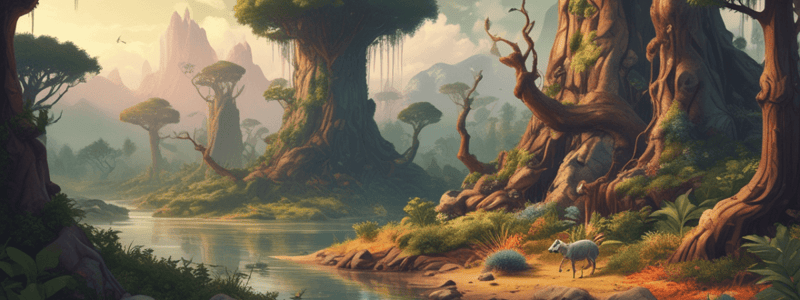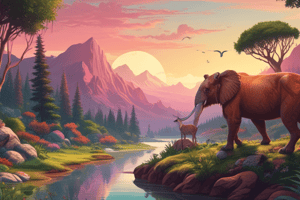Podcast
Questions and Answers
What type of biome is a coral reef?
What type of biome is a coral reef?
- Freshwater
- Tundra
- Marine (correct)
- Desert
Which biome is known for having permafrost?
Which biome is known for having permafrost?
- Rainforest
- Desert
- Alpine Tundra
- Arctic Tundra (correct)
Where can tundra biomes be found?
Where can tundra biomes be found?
- India and China
- Greenland and Iceland (correct)
- Egypt and Australia
- Mexico and Brazil
What makes coral reefs sometimes referred to as the rainforests of the ocean?
What makes coral reefs sometimes referred to as the rainforests of the ocean?
Which animals are commonly found in the arctic tundra?
Which animals are commonly found in the arctic tundra?
What distinguishes alpine tundras from arctic tundras?
What distinguishes alpine tundras from arctic tundras?
What characterizes the tundra biome in terms of rainfall?
What characterizes the tundra biome in terms of rainfall?
At what latitudes are tundra biomes usually located?
At what latitudes are tundra biomes usually located?
Why are tundra biomes referred to as treeless?
Why are tundra biomes referred to as treeless?
The months in total darkness in the tundra biome are due to:
The months in total darkness in the tundra biome are due to:
What is unique to the permafrost found in the tundra biome?
What is unique to the permafrost found in the tundra biome?
Flashcards are hidden until you start studying
Study Notes
Biomes
- A biome is a regional area characterized by the plants, animals, and climate in that area.
- There are five primary biomes: Grassland, Desert, Forest, Aquatic, and Tundra.
Tundra Biomes
- Characterized as a treeless polar desert.
- Located in high latitudes and can be divided into two categories: arctic tundra and alpine tundra.
- Temperatures in the tundra can reach -22 degrees Fahrenheit, with rainfall less than 6 to 10 inches per year.
- Permafrost is permanently frozen ground located under the soil, unique to this biome.
Arctic Tundra
- Covers one fifth of the surface on Earth, found at the North Pole above the tree line.
- Temperatures can reach -50 degrees Fahrenheit, with summers only 50 to 60 days in length.
- Harsh temperatures cause the land to be barren, with animals including arctic foxes, polar bears, and musk oxen.
Alpine Tundra
- Found further away from the poles, with higher temperatures and a wider range of precipitation.
- Summers range from 37 to 53 degrees Fahrenheit, and winters rarely below zero degrees Fahrenheit.
Grassland Biomes
- Located in middle latitudes, divided into savannas and temperate grasslands.
- Savannas are located near the equator, with warm year-round climates, covering over half of Africa and large portions of Australia, South America, and India.
- Temperate grasslands are found in regions including Argentina, Australia, and the central part of North America.
Desert Biomes
- Cover about one fifth of Earth's land surface, receiving very little precipitation.
- Four main types of deserts: hot and dry, semi-arid, coastal, and cold.
Forest Biomes
- Cover about one-third of Earth, found in various locations with varied climates.
- Four types of forest biomes: temperate deciduous forests, tropical rainforests, jungles, and taiga/boreal forests.
Aquatic Biomes
- The largest of all biomes, covering almost 75% of Earth.
- Can be divided into two main categories: freshwater and marine.
Studying That Suits You
Use AI to generate personalized quizzes and flashcards to suit your learning preferences.




